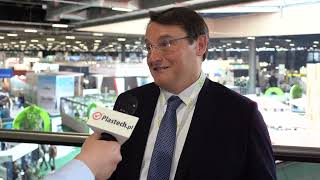The throughput rate of Helibar is optimized by the use of spiral grooves which, in addition, are characterized by improved self cleaning and less friction. Added to that is the extremely advantageous pressure built-up capability of up to 800 bar at the screw tip; this feature is particularly important in extrusion blow moulding of up to 12 bottles along melt paths of considerable distance. The advantage of the groove technology is accompanied by low RPM at equal throughput and pressure build-up.
This leads to the conclusion that, for instance, the smaller 45 OD screw Helibar can easily compete with a larger 60 OD extruder of grooved bushing design: “Here is our leading edge when it comes to lower heat emission, reduced space requirements and a smaller and low-cost drive system”, continues manager Wahl.
The Helibar cooling system can, in 90 percent of cases – dependant on the die/mould and type of material – do without an expensive water cooling system: - The less expensive air cooling system is entirely sufficient, frequently offering the passive variant (free convection) when processing HDPE and many PP types. In addition, the mixing of virgin materials with regrind material and masterbatch does not present Helibar with a processing challenge”, the inventor Grünschloß summarizes.
The breadth of application of Helibar ranges at present from extrusion blow moulding processes for bottles, using HDPE, PP, and PET, etc. (drinks, foodstuffs, cosmetics, chemical/medical solutions, cleaning agents, motor oil, fuel and many more), to sheet and film extrusion as well as cable coating on large equipment right through to operations with smaller 25 to 30 mm screw diameter Helibar models as co-extruders for the processing of PA, EVOH and PVDF and up to seven layers.
The demand for ever smaller batches and more frequent change in materials and colour – also in the field of cable coating – makes Helibar the economic workhorse. The advantage of self-cleaning: reduced material wastage with the smaller Helibar models when compared with larger extruders. The frequently posed question about possible deposits in the cylinder grooves is answered by Grünschloss as follows: “At a thickness of between 0.5 and 1 mm, the grooves are extremely flat which makes purging a much faster process when compared with the considerably deeper screw channels.”
High pressure build-up ability and pressure stability, as well as excellent colouring and mixing quality using masterbatch – these are the differentiating positive factors for efficient extrusion blow moulding, regular pipe or corrugated pipe extrusion and for cable coating.
Extrudex introduces economic single-screw Helibar extruder at K 2010
- Pages:
- 1
- 2


